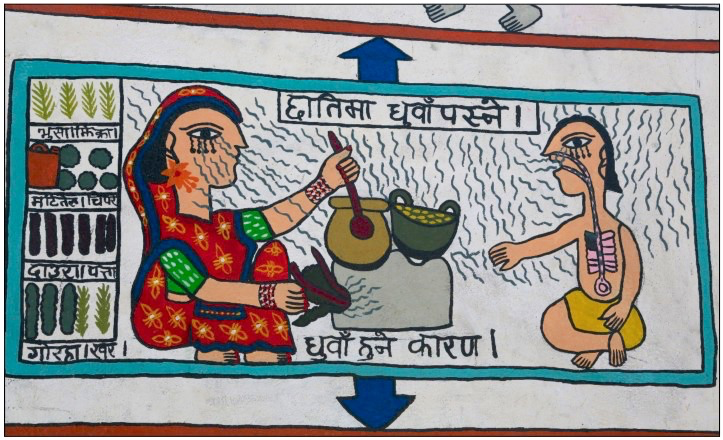


Through your generosity we have raised over $100,000, and it continues to flow in.
EXTRA SPECIAL THANKS to all of you who have donated, and told us “spend it where it will do the most good” – we’re grateful to you for your generosity, and your trust.
Here’s what we’ve done, and are doing – This is a partial list. Sorry that it’s so long – As Mark Twain reportedly said “If I had more time I would have written a shorter letter.”
400 Tarpaulins for temporary shelter were brought in from India and distributed.
Water Purification Systems
24 family systems were distributed in the immediate aftermath of the Earthquake.
38 small community-scale systems are en-route to Nepal for extended distribution –
Special thanks to EarthEasy/LifeStraw and MSR/Cascade Designs for making these excellent systems available and affordable.
Locally sourced solar systems were provided to the Nuns of the Bigu convent – we taught them how to do the installation (“Women’s Empowerment”), and they will move the systems when their facility is rebuilt.
An additional 200 Solar Lighting Systems are en-route from the US for the Langtang families (see below) and 81 additional families –
Special thanks to LuminAID for generous donation and support.
20 stoves have been delivered to end-users (or are about to be delivered) and are being used to provide community feeding in some of the hardest hit areas.
Details of where they are being used are below in the “Working with the Buddhist Monasteries and Convents” section.
Special thanks to Envirofit for financial and logistics support in obtaining these stoves getting them into Nepal.
The village of Langtang was totally destroyed by avalanches after the first earthquake. Langtang was the hardest-hit village in Nepal.
Special thanks to the BBC for permission to use their video.
119 surviving families were air-evacuated to temporary quarters in the outskirts of Kathmandu, and will be moving back (and rebuilding) after the monsoon season is over.
Domestic/Family stoves were given to them:
They will be taking their new stoves with them – one less thing for them to worry about, and are getting the LuminAID Solar Lighting Systems when they reach Nepal.
Working with the Buddhist Monasteries and Convents
Our tireless and incredibly effective colleague, Jai Rajbhandari, sent us this summary:
After the devastating earthquake, most of the monasteries outside the Kathmandu Valley were badly hit or destroyed completely. Most of the buildings were made out of mud, stone and wood. After the quake most of the nuns and monks were shifted to Kathmandu by helicopter and buses.
For some it was easy to come to the capital but for some they had to go through different sort of hassles.
Some of them were accused of child trafficking as well.
We were approached by four different monasteries from Dolkha, a city on the north east of Kathmandu at a distance of 5 hours drive. Dolkha is the second city after Barpak, the first epicenter of the earthquake. Till this date Dolkha is getting after-shocks. The nuns and monks are staying in temporary shelter homes in Kathmandu built by different donors. Their monasteries are nothing more than a heap of stove and mud at present. Everything is needed to start from the scratch and they are not sure where to start.
To encourage and support them to move forward, we, as Himalayan Stove Project, have provided several pieces of institutional stoves to the monasteries. Biggu Gompa (Nunnery), Phulaune Gompa, Chotang community.
The Biggu Gompa have young nuns who attend a school in Baudha. We have taken care of their school related expenses such as books, stationeries and some other necessities.
In addition to continuing with the projects described above, we are searching out additional needs where our capabilities can be useful.
One interesting project that “appeared” in the last few days, as reported by Jai, is:
“I just got an inquiry whether we can support an income generation project around Dolkha to come out from the stress of earthquake. They want to start up shitake mushroom cultivation, which is good for that area. They are looking for a source of fund”.
Tourism is a major part of the economy of Nepal and provides lots of employment; particularly in the remote areas where we are active.
Encouraging people to come and visit Nepal NOW (the monsoons are almost over) will do a lot to help stabilize and restore the country’s economic health – plan a trip, and encourage your friends and colleagues to consider one.
Almost the entire country is safe and accessible – we are constantly obtaining up-to-the-minute information from a small group of trusted colleagues and correspondents regarding areas that are wonderful, safe and accessible, and will be posting (and continuously updating) this information on our website so that you will have current information on places to go and enjoy the splendors of this magnificent country and its wonderful people.
We are following a three-pronged approach:
#1 – Continuing with our primary mission of providing Clean CookStoves – Family / Domestic units and Institutional Stoves.
#2 – Delivering help, assistance and financial support for selected projects and communities, where we can continue in the role of catalyst to bring in other donors and support systems.
#3 – Continuing to engage in the process of providing reliable, credible information to help reboot the travel and tourism industry, which is a huge economic factor in Nepal.
The needs are enormous, and many opportunities exist where we can be catalysts in helping the people to become more self-sufficient, rather than just throwing money at a problem.
Last, but not least by any means, VERY, VERY, VERY SPECIAL THANKS TO JAI RAJBHANDARI, our trusted colleague and good friend in Kathmandu, who facilitated and implemented all these successful efforts in Nepal (while simultaneously dealing with his personal concerns of family, extended family and legions of friends).
THANKS, Jai; your help has been awesome – we couldn’t have done it without you.
Here’s an article that appeared about us recently:
http://voicesforbiodiversity.org/articles/clean-stoves-and-healthy-forests



Thank you for contacting Himalayan Stove Project. You have been successfully subscribed to our newsletter!